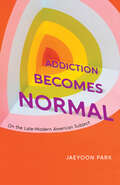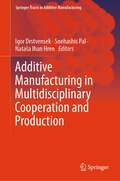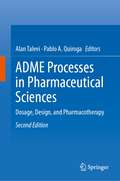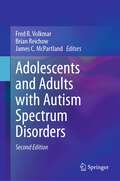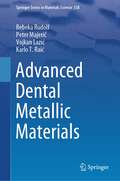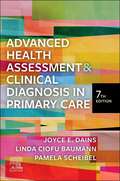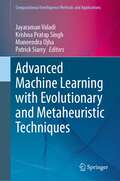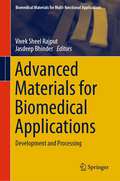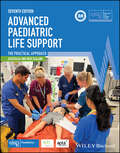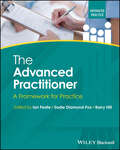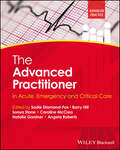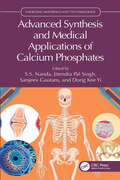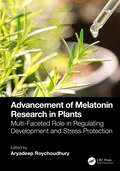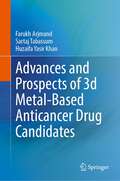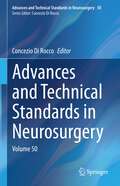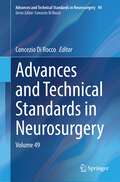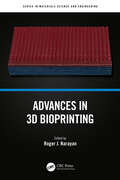- Table View
- List View
Addiction Becomes Normal: On the Late-Modern American Subject
by Jaeyoon ParkAddiction is now seen as an ordinary feature of human nature, an idea that introduces new doubts about the meaning of our desires. Over the last forty years, a variety of developments in American science, politics, and culture have reimagined addiction in their own ways, but they share an important understanding: increasingly, addiction is described as normal, the natural result of a body that has been exposed to potent stimuli. This shift in thinking suggests that addiction is a condition latent in all of us, a common response to a society rich in thrills. In Addiction Becomes Normal, Jaeyoon Park provides a history and critical analysis of the normalization of addiction in late-modern American society. By exploring addiction science, diagnostic manuals, judicial reform, and public health policy, he shows how seeing addiction as normal has flourished in recent decades and is supported throughout cultural life in the United States by the language of wellness, psychotherapy, and more. Building on Michel Foucault’s depiction of the human figure, Park argues that this shift reflects the emergence of a new American subject, one formed by the accretion of experiences. This view of the human subject challenges the idea that our compulsions reflect our characters, wills, or spirits. For if addiction is an extreme but ordinary attachment, and if compulsive consumption resembles healthy behavior, then desire is no longer an expression of the soul so much as the pursuit of a past reward. A perceptive work of recent history and political theory, Addiction Becomes Normal raises new questions about what it means to be human in America today.
Addiction Becomes Normal: On the Late-Modern American Subject
by Jaeyoon ParkAddiction is now seen as an ordinary feature of human nature, an idea that introduces new doubts about the meaning of our desires. Over the last forty years, a variety of developments in American science, politics, and culture have reimagined addiction in their own ways, but they share an important understanding: increasingly, addiction is described as normal, the natural result of a body that has been exposed to potent stimuli. This shift in thinking suggests that addiction is a condition latent in all of us, a common response to a society rich in thrills. In Addiction Becomes Normal, Jaeyoon Park provides a history and critical analysis of the normalization of addiction in late-modern American society. By exploring addiction science, diagnostic manuals, judicial reform, and public health policy, he shows how seeing addiction as normal has flourished in recent decades and is supported throughout cultural life in the United States by the language of wellness, psychotherapy, and more. Building on Michel Foucault’s depiction of the human figure, Park argues that this shift reflects the emergence of a new American subject, one formed by the accretion of experiences. This view of the human subject challenges the idea that our compulsions reflect our characters, wills, or spirits. For if addiction is an extreme but ordinary attachment, and if compulsive consumption resembles healthy behavior, then desire is no longer an expression of the soul so much as the pursuit of a past reward. A perceptive work of recent history and political theory, Addiction Becomes Normal raises new questions about what it means to be human in America today.
Additive Manufacturing in Multidisciplinary Cooperation and Production (Springer Tracts in Additive Manufacturing)
by Igor Drstvensek Snehashis Pal Nataša Ihan HrenThis book publishes the latest findings and ideas in the field of additive manufacturing presented by authors from prominent institutions around the world at the iCAT 2023 conference. The authors address various technological and medical aspects, ranging from materials science to the specific behaviour of the technology under different working conditions. The book is divided into four sections, three of which are dedicated to the purely technological aspects of additive manufacturing, covering metal processes, polymer processes and simulation. The fourth part of the book is dedicated to the medical applications of additive manufacturing, covering areas ranging from orthopaedic surgeries to materials used in medical AM.Overall, the book provides insight into the current state of the science and applications of additive manufacturing.
ADME Processes in Pharmaceutical Sciences: Dosage, Design, and Pharmacotherapy
by Alan Talevi Pablo A. QuirogaAbsorption, Distribution, Metabolism and Excretion (ADME) processes and their relationship with the design of dosage forms and the success of pharmacotherapy form the basis of this upper level undergraduate/graduate textbook. Whereas primarily oriented to Pharmacy students and graduates, it can also be useful for scientist from different fields elated to pharmaceutics and pharmacology. (e.g., material scientists, material engineers, medicinal chemists, physicians) who might be working in a positions in pharmaceutical companies or whose work might benefit from basic training in the ADME concepts and related biological background.Pedagogical features such as objectives, keywords, discussion questions, summaries and case studies are included as teaching tools. This book will provide not only general knowledge on ADME processes but also an updated insight on some hot topics such as drug transporters, multi-drug resistance related to pharmacokinetic phenomena, last generation pharmaceutical carriers (nanopharmaceuticals), in vitro and in vivo bioequivalence studies, biopharmaceuticals, pharmacogenomics, drug-drug and food-drug interactions, in silico and in vitro prediction of ADME properties, or chronopharmacokinetic. In comparison with other similar textbooks, around half of the volume would be focused on the relationship between expanding scientific fields and ADME processes. Each of these burgeoning fields has a separate chapter in the second part of the volume, and is written with experts on the correspondent topic, including industrial scientists and academics from USA and UK.Additionally, each of the initial chapters dealing with the generalities of drug absorption, distribution, metabolism and excretion would include relevant, classic examples related to each topic with appropriate illustrations. ADME Processes and Pharmaceutical Sciences is written as a core textbook for courses on pharmaceutical sciences: pharmacology, pharmacokinetics,drug delivery, biopharmaceutics, drug design and medicinal chemistry courses.
Adolescents and Adults with Autism Spectrum Disorders
by Fred R. Volkmar Brian Reichow James C. McPartlandThe second edition of this book examines the numerous research and practice advances with regard to adolescents and adults with autism spectrum disorders (ASD). Expert contributors offer cogent reviews of complex issues, from education to employment, leisure activities to illegal behaviors, mental health issues to medical health concerns. The volume explores the latest findings in key areas, such as psychosocial and residential treatments, social skills programs, epidemiology, the impact of ASD on families. The book focuses on areas of research and practice that require improved models of assessment, current data, new interventions, and increased support services. Key areas of coverage include: Transition from high school to adulthood for adolescents and young adults with ASD. Innovative programming to support college students with ASD. Romantic relationships, sexuality and ASD. Treatment of mental health comorbidities. Assessment and treatment planning in adults with ASD. The range of outcomes and challenges in middle and later life for individuals with autism. The second edition of Adolescents and Adults with Autism Spectrum Disorders is a must-have reference for researchers, professors, and graduate students as well as clinicians, therapists, and other practitioners in clinical child, school, and developmental psychology, psychiatry, social work, rehabilitation medicine/therapy, special education, and general practice/family medicine.
Advanced Dental Metallic Materials (Springer Series in Materials Science #338)
by Rebeka Rudolf Peter Majerič Vojkan Lazić Karlo T. RaićThis book delivers a broad and concise look at advanced metallic materials used for dental applications. Due to their excellent mechanical and biological properties, the use of metallic materials in dentistry has continued since time immemorial. In that sense, this book aims to bring the readers closer to the specific purpose of dental metallic materials meeting specific criteria and materials properties such as biocompatibility, non-toxicity, resistance to corrosion, long-term durability, appropriate strength and toughness, as well as corresponding values of modulus of elasticity. Following a comprehensive introduction to the field, the book discusses topical issues such as the long-term stability of dental titanium implants, processing of cobalt-chrome dental alloys, emerging gold dental alloys, and novel nanofoils used for dental joining. Featuring numerous illustrative examples of experimental outcomes, this book is an ideal resource for materials scientists and metallurgists working on advanced alloys for dental applications.
Advanced Health Assessment & Clinical Diagnosis in Primary Care - E-Book
by Joyce E. Dains Linda Ciofu Baumann Pamela ScheibelTake the next step in health assessment by building your skills in diagnostic and clinical reasoning! Advanced Health Assessment and Clinical Diagnosis in Primary Care, 7th Edition goes beyond the basic physical examination to help you learn to accurately evaluate common conditions. Organized by patient symptoms or complaints, the book follows a systematic approach beginning with a chief concern rather than a specific diagnosis or disease entity, then guides you step-by-step through a diagnostic reasoning process to lead to a clinical diagnosis. This edition includes new chapters on veterans’ health and on contemporary approaches in primary care settings, as well as updated content on issues such as race, ethnicity, and gender identity. Written by a team of advanced practitioners led by Joyce E. Dains, this AJN award-winning text helps you learn to think like an expert clinician.
Advanced Machine Learning with Evolutionary and Metaheuristic Techniques (Computational Intelligence Methods and Applications)
by Jayaraman Valadi Krishna Pratap Singh Muneendra Ojha Patrick SiarryThis book delves into practical implementation of evolutionary and metaheuristic algorithms to advance the capacity of machine learning. The readers can gain insight into the capabilities of data-driven evolutionary optimization in materials mechanics, and optimize your learning algorithms for maximum efficiency. Or unlock the strategies behind hyperparameter optimization to enhance your transfer learning algorithms, yielding remarkable outcomes. Or embark on an illuminating journey through evolutionary techniques designed for constructing deep-learning frameworks. The book also introduces an intelligent RPL attack detection system tailored for IoT networks. Explore a promising avenue of optimization by fusing Particle Swarm Optimization with Reinforcement Learning. It uncovers the indispensable role of metaheuristics in supervised machine learning algorithms. Ultimately, this book bridges the realms of evolutionary dynamic optimization andmachine learning, paving the way for pioneering innovations in the field.
Advanced Materials for Biomedical Applications: Development and Processing (Biomedical Materials for Multi-functional Applications)
by Vivek Sheel Rajput Jasdeep BhinderThis book provides an insight into the basic fundamentals of the biomaterials used for the biomedical applications, their development and processing techniques. Advanced materials are significantly utilized for the biomedical applications ranging from dental devices to cancer treatment owing to their higher biocompatibility and better interaction with tissues. This book covers the various topics that include basic biocompatibility phenomena, insight to materials science, class of different advanced materials as a biomaterials, development and processing techniques, design and analysis of the developed advanced materials, investigation of its properties and major applications. Recent information regarding the development techniques and methods for improving the properties of the advanced materials in the field of biomedical applications is highlighted in detail. The textbook offers clear explanation of the text in the chapters with self-explanatory figures and tables. It demonstrates the novel methods, opportunities and ideas for developing biomaterials in the field of biomedical applications. It also includes critical review study of the developed advanced materials for biomedical applications in a new summarized form. The inclusion of the discussions on hybrid polymer-based composites and self-healing composite materials offers a special feature in the textbook. It features a thorough overview of the simulation aspect in the biomedical applications. The book features at least 50% of its references from last three–four years’ work in the field of biomaterials and biomedical. The book content adds to the redundancy in the literature work related to biomedical and biomaterials.This book is a valuable resource for academicians, students and scholars from science and engineering background having interest in biomaterials. It is helpful to the biomedical engineering group especially in countries or location where they don’t have access to the major journals.
Advanced Paediatric Life Support, Australia and New Zealand: The Practical Approach (Advanced Life Support Group)
by Advanced Life Support Group Alsg Advanced Paediatric Life Support AplsADVANCED PAEDIATRIC LIFE SUPPORT The gold standard for treating paediatric emergencies Advanced Paediatric Life Support, Australia and New Zealand: A Practical Approach to Emergencies is the internationally renowned manual on emergency paediatric care. This text reinforces the course developed by the Advanced Life Support Group and utilises their tried and tested method of treating children in the event of a life-threatening illness or injury. Adapted specifically for Australia and New Zealand, this edition is a trusted resource used by qualified medical professionals dealing with emergencies involving paediatric patients. With a clear layout and straightforward style, this text can be used as a functional tool both for training and in the event of an emergency. In this seventh edition you will find descriptions of both common and uncommon paediatric emergencies which may be encountered in clinical practice, along with their causes, and how to best treat them during the first hours after presentation. This text offers an evidence-based approach to its subject, which includes: The latest Australia and New Zealand Resuscitation Councils (ANZCOR) guidelines A thorough introduction to the structured approach to paediatric emergencies, including important non-technical skills and communication Comprehensive explorations of the seriously ill child, including airway and breathing, circulation, decreased consciousness, seizures and exposure Practical discussions of the seriously injured child, including examinations of chest, abdominal, brain and spinal injuries Evidence-based life support treatment and the practical application of the Advanced Paediatric Life Support structured management Perfect for emergency care physicians, nurses and other allied health professionals, Advanced Paediatric Life Support, Australia and New Zealand: A Practical Approach to Emergencies will also benefit paediatric clinicians, doctors-in-training and anyone else with an interest in the team management and treatment of paediatric emergencies. Advanced Life Support Group (ALSG) is a Manchester, UK, -based charitable organisation whose medical education and training programmes improve outcomes for people in life-threatening situations, anywhere along the health care pathway, anywhere in the world. As a charity, ALSG invests all profits in educational resources and partners with the most effective and respected organisations worldwide to develop exceptionally high-quality programmes.
Advanced Paediatric Life Support, Australia and New Zealand: The Practical Approach (Advanced Life Support Group)
by Stephanie SmithADVANCED PAEDIATRIC LIFE SUPPORT The gold standard for treating paediatric emergencies Advanced Paediatric Life Support, Australia and New Zealand: A Practical Approach to Emergencies is the internationally renowned manual on emergency paediatric care. This text reinforces the course developed by the Advanced Life Support Group and utilises their tried and tested method of treating children in the event of a life-threatening illness or injury. Adapted specifically for Australia and New Zealand, this edition is a trusted resource used by qualified medical professionals dealing with emergencies involving paediatric patients. With a clear layout and straightforward style, this text can be used as a functional tool both for training and in the event of an emergency. In this seventh edition you will find descriptions of both common and uncommon paediatric emergencies which may be encountered in clinical practice, along with their causes, and how to best treat them during the first hours after presentation. This text offers an evidence-based approach to its subject, which includes: The latest Australia and New Zealand Resuscitation Councils (ANZCOR) guidelines A thorough introduction to the structured approach to paediatric emergencies, including important non-technical skills and communication Comprehensive explorations of the seriously ill child, including airway and breathing, circulation, decreased consciousness, seizures and exposure Practical discussions of the seriously injured child, including examinations of chest, abdominal, brain and spinal injuries Evidence-based life support treatment and the practical application of the Advanced Paediatric Life Support structured management Perfect for emergency care physicians, nurses and other allied health professionals, Advanced Paediatric Life Support, Australia and New Zealand: A Practical Approach to Emergencies will also benefit paediatric clinicians, doctors-in-training and anyone else with an interest in the team management and treatment of paediatric emergencies. Advanced Life Support Group (ALSG) is a Manchester, UK, -based charitable organisation whose medical education and training programmes improve outcomes for people in life-threatening situations, anywhere along the health care pathway, anywhere in the world. As a charity, ALSG invests all profits in educational resources and partners with the most effective and respected organisations worldwide to develop exceptionally high-quality programmes.
Advanced Practice Nurse Networking to Enhance Global Health (Advanced Practice In Nursing Ser.)
by Melanie Rogers Daniela Lehwaldt Josette Roussel Michelle AcornAdvanced Practice Nurse Networking to Enhance Global Health (Advanced Practice in Nursing)
by Melanie Rogers Daniela Lehwaldt Josette Roussel Michelle AcornThis book is the first bringing together the work of the ICN NP/APN Network, recognised as the leading authority on advanced practice nursing globally. Since its inception a wide range of projects have been conducted. This book offers readers an overview of global developments led by the Network on advanced practice in addition to findings related to education, research, health policy and clinical practice. This volume recognises the benefits and challenges associated with the development of advanced practice nursing globally. It begins with an overview of the Network before discussing some of the global challenges. The second section of the book presents a variety of the Network's projects and evidence informed data on APN role. This book presents the global context of advanced practice in a variety of settings; As such it is relevant for APNs, students, health policy makers, educators and researchers.
The Advanced Practitioner: A Framework for Practice (Advanced Clinical Practice)
by Ian Peate Sadie Diamond-Fox Barry HillThe Advanced Practitioner An essential text for Advanced Practitioners In The Advanced Practitioner: A Framework for Practice, a team of distinguished Advanced Practitioners (APs) and academics deliver the go-to text for trainee APs, with a strong focus on the four pillars that underpin advanced practice: clinical practice, education, research, and leadership. The patient is at the core of this essential resource, which offers the knowledge required to care safely for people in a variety of care settings, as well as with a range of common and specialised holistic interventions. Readers will also find: A thorough introduction to the core principles of advanced practice, including the AP curriculum and the principles of physiology, pharmacology, and pathophysiology Comprehensive exploration of the clinical pillar, including discussions of clinical history taking and physical examination Practical discussion of the education and research pillars, including an exploration of research principles and education and learning Discussion of innovation in practice, the leadership pillar, and how to deal with difficult situations Perfect for trainee advanced practitioners, The Advanced Practitioner: A Framework for Practice will also benefit healthcare students and trainee medical associate professionals.
The Advanced Practitioner: A Framework for Practice (Advanced Clinical Practice)
by Ian Peate Sadie Diamond Fox Barry HillThe Advanced Practitioner An essential text for Advanced Practitioners In The Advanced Practitioner: A Framework for Practice, a team of distinguished Advanced Practitioners (APs) and academics deliver the go-to text for trainee APs, with a strong focus on the four pillars that underpin advanced practice: clinical practice, education, research, and leadership. The patient is at the core of this essential resource, which offers the knowledge required to care safely for people in a variety of care settings, as well as with a range of common and specialised holistic interventions. Readers will also find: A thorough introduction to the core principles of advanced practice, including the AP curriculum and the principles of physiology, pharmacology, and pathophysiology Comprehensive exploration of the clinical pillar, including discussions of clinical history taking and physical examination Practical discussion of the education and research pillars, including an exploration of research principles and education and learning Discussion of innovation in practice, the leadership pillar, and how to deal with difficult situations Perfect for trainee advanced practitioners, The Advanced Practitioner: A Framework for Practice will also benefit healthcare students and trainee medical associate professionals.
The Advanced Practitioner in Acute, Emergency and Critical Care (Advanced Clinical Practice)
by Ian PeateThe Advanced Practitioner in Acute, Emergency and Critical Care Dedicated text for trainee and newly-qualified Advanced Practitioners specialising in acute, emergency and critical care Aligned with the Nursing and Midwifery Council (NMC) and the Health and Care Professions Council (HCPC) regulatory body requirements, this formative text is the first of its kind, covering a variety of key topics for advanced practitioners working in acute, emergency and critical care. Written by experienced advanced practitioners and academics closely involved in the delivery of both the clinical and academic components of advanced practice training programmes, The Advanced Practitioner in Acute, Emergency and Critical Care presents: Complex decision making, covering legal and ethical frameworks (including patient safety), communication skills and breaking bad news, and end of life care Diagnosis and management of patients, covering radiology, principles of point of care ultrasound (PoCUS), laboratory tests and prescribing Resuscitation and first stage management of the critically unwell, advanced resuscitation skills, shock, intra- and inter-hospital transfers, and organ donation History taking, physical examination, and consultation models Learning support with accreditation considerations boxes, clinical investigations, examination scenarios, pharmacology boxes, pathological and psychological considerations, social and cultural considerations, case studies, self-assessment questions, and more Utilising a multi-professional and inclusive framework of advanced level practice, this is an essential resource for all trainee and newly-qualified advanced practitioners. The text also serves as an excellent classroom aid for lecturers teaching advanced practice courses.
The Advanced Practitioner in Acute, Emergency and Critical Care (Advanced Clinical Practice)
by Ian PeateThe Advanced Practitioner in Acute, Emergency and Critical Care Dedicated text for trainee and newly-qualified Advanced Practitioners specialising in acute, emergency and critical care Aligned with the Nursing and Midwifery Council (NMC) and the Health and Care Professions Council (HCPC) regulatory body requirements, this formative text is the first of its kind, covering a variety of key topics for advanced practitioners working in acute, emergency and critical care. Written by experienced advanced practitioners and academics closely involved in the delivery of both the clinical and academic components of advanced practice training programmes, The Advanced Practitioner in Acute, Emergency and Critical Care presents: Complex decision making, covering legal and ethical frameworks (including patient safety), communication skills and breaking bad news, and end of life care Diagnosis and management of patients, covering radiology, principles of point of care ultrasound (PoCUS), laboratory tests and prescribing Resuscitation and first stage management of the critically unwell, advanced resuscitation skills, shock, intra- and inter-hospital transfers, and organ donation History taking, physical examination, and consultation models Learning support with accreditation considerations boxes, clinical investigations, examination scenarios, pharmacology boxes, pathological and psychological considerations, social and cultural considerations, case studies, self-assessment questions, and more Utilising a multi-professional and inclusive framework of advanced level practice, this is an essential resource for all trainee and newly-qualified advanced practitioners. The text also serves as an excellent classroom aid for lecturers teaching advanced practice courses.
Advanced Synthesis and Medical Applications of Calcium Phosphates (Emerging Materials and Technologies)
Calcium phosphate materials are used in many medical and dental applications. Advanced Synthesis and Medical Applications of Calcium Phosphates covers the structure, chemistry, synthesis, and properties of both natural and synthetic calcium-based biomaterials and details a variety of medical applications. Depicts the latest advances in using calcium phosphates in bone regeneration and tissue engineering Includes the latest generation of regenerative biomaterials with an integrated perspective combining both research and clinical issues Provides an understanding of the clinical targets and requirements for regenerative medicine Detailing fundamentals through applications, this book helps biomaterials researchers to better understand the clinical targets and requirements for use of these materials for optimal synthesis and development.
Advanced Synthesis and Medical Applications of Calcium Phosphates (Emerging Materials and Technologies)
by S. S. Nanda Jitendra Pal Singh Sanjeev Gautam Dong Kee YiCalcium phosphate materials are used in many medical and dental applications. Advanced Synthesis and Medical Applications of Calcium Phosphates covers the structure, chemistry, synthesis, and properties of both natural and synthetic calcium-based biomaterials and details a variety of medical applications. Depicts the latest advances in using calcium phosphates in bone regeneration and tissue engineering Includes the latest generation of regenerative biomaterials with an integrated perspective combining both research and clinical issues Provides an understanding of the clinical targets and requirements for regenerative medicine Detailing fundamentals through applications, this book helps biomaterials researchers to better understand the clinical targets and requirements for use of these materials for optimal synthesis and development.
Advancement of Melatonin Research in Plants: Multi-Faceted Role in Regulating Development and Stress Protection
by Aryadeep RoychoudhuryMelatonin (N-acetyl-5-methoxytryptamine) is a widely studied biomolecule, and its function has been investigated in bacteria, mammals, birds, amphibians, reptiles, fish and plants. Melatonin research in plants the last five years has attained an exponential growth phase and the number of publications related to phytomelatonin has significantly increased in present times. All this research is directed towards establishing multifarious roles of melatonin in plants, including the promotion of seed germination and seedling growth, influencing plant development and senescence, alteration of flowering and fruiting time and grain yield, modulating circadian rhythms, improving resistance against biotic stress as well as tolerance to abiotic stress, reducing oxidative stress, and stimulating plant immune response. However, to date, an exhaustive book, solely and exclusively dedicated to melatonin research on various aspects of plant biology, has not been published by any renowned publisher or is available in the market. Keeping all these facts in mind, this book aims to compile the most recent developments in the arena of melatonin-mediated regulation of plant physiology under optimal and sub-optimal conditions. This book will initiate and introduce the readers to the state-of-the-art developments and trends in this field of study and will largely cater to the scientific need of scientists engaged in melatonin research across the globe. The book will be unique of its kind and will draw the attention of scientific and research communities engaged in the field of melatonin research.The key features of this book: Authors will address the topics which would provide advances in the understanding of diverse functions of melatonin in plants, encompassing almost all the aspects that have been investigated so far Integrate the overall mechanistic function of melatonin, genomics and proteomics tools, and genetic engineering to manipulate endogenous melatonin levels, thus giving a holistic view of plant-level studies under normal or challenging situations Largely help the readers to design future research programs in exploiting melatonin as a protective agent to develop climate-resilient and pathogen-resistant plants Benefit the crop protection program and ensure food security Chapters will be supplemented with ample illustrations and figures This book will be beneficial to research scholars and Ph.D. students involved in melatonin research and working on stress physiology, stress proteins, genomics, proteomics and genetic engineering in different universities and research institutes all over the world. The book can also be used as an advanced reference book for the coursework of research and master’s level students. It will be of use to people involved in improving plant growth and yield, as well as the performance of plant species in the face of climate change and pathogen infection, using melatonin as the prime protective agent and signaling molecule. Although the book will directly benefit the academic and scientific community, it will also indirectly draw the attention of industries or companies that manufacture or sell chemical products, since the book will highlight in detail the antioxidative potential of melatonin. This will create impetus at the industrial level for the isolation and synthesis of melatonin as a beneficial chemical agent. Applying melatonin as an ameliorating agent against different stresses at the field level will also increase the demand for this chemical among the farmers and will promote large-scale sales and utilization of melatonin for ensuring crop protection and increasing yield.
Advancement of Melatonin Research in Plants: Multi-Faceted Role in Regulating Development and Stress Protection
by Aryadeep RoychoudhuryMelatonin (N-acetyl-5-methoxytryptamine) is a widely studied biomolecule, and its function has been investigated in bacteria, mammals, birds, amphibians, reptiles, fish and plants. Melatonin research in plants the last five years has attained an exponential growth phase and the number of publications related to phytomelatonin has significantly increased in present times. All this research is directed towards establishing multifarious roles of melatonin in plants, including the promotion of seed germination and seedling growth, influencing plant development and senescence, alteration of flowering and fruiting time and grain yield, modulating circadian rhythms, improving resistance against biotic stress as well as tolerance to abiotic stress, reducing oxidative stress, and stimulating plant immune response. However, to date, an exhaustive book, solely and exclusively dedicated to melatonin research on various aspects of plant biology, has not been published by any renowned publisher or is available in the market. Keeping all these facts in mind, this book aims to compile the most recent developments in the arena of melatonin-mediated regulation of plant physiology under optimal and sub-optimal conditions. This book will initiate and introduce the readers to the state-of-the-art developments and trends in this field of study and will largely cater to the scientific need of scientists engaged in melatonin research across the globe. The book will be unique of its kind and will draw the attention of scientific and research communities engaged in the field of melatonin research.The key features of this book: Authors will address the topics which would provide advances in the understanding of diverse functions of melatonin in plants, encompassing almost all the aspects that have been investigated so far Integrate the overall mechanistic function of melatonin, genomics and proteomics tools, and genetic engineering to manipulate endogenous melatonin levels, thus giving a holistic view of plant-level studies under normal or challenging situations Largely help the readers to design future research programs in exploiting melatonin as a protective agent to develop climate-resilient and pathogen-resistant plants Benefit the crop protection program and ensure food security Chapters will be supplemented with ample illustrations and figures This book will be beneficial to research scholars and Ph.D. students involved in melatonin research and working on stress physiology, stress proteins, genomics, proteomics and genetic engineering in different universities and research institutes all over the world. The book can also be used as an advanced reference book for the coursework of research and master’s level students. It will be of use to people involved in improving plant growth and yield, as well as the performance of plant species in the face of climate change and pathogen infection, using melatonin as the prime protective agent and signaling molecule. Although the book will directly benefit the academic and scientific community, it will also indirectly draw the attention of industries or companies that manufacture or sell chemical products, since the book will highlight in detail the antioxidative potential of melatonin. This will create impetus at the industrial level for the isolation and synthesis of melatonin as a beneficial chemical agent. Applying melatonin as an ameliorating agent against different stresses at the field level will also increase the demand for this chemical among the farmers and will promote large-scale sales and utilization of melatonin for ensuring crop protection and increasing yield.
Advances and Prospects of 3-d Metal-Based Anticancer Drug Candidates
by Farukh Arjmand Sartaj Tabassum Huzaifa Yasir KhanThis book reviews the potential of metallodrugs against different cancer. It summarizes the classification of metal-based anti-cancer drugs, their plausible biochemical and mechanistic pathways, combining drug strategies for hitting multiple therapeutic targets at the intracellular level, and advanced drug delivery strategies. The book covers the metallodrugs for the efficacious treatment of diverse cancerous strains and recent advances in drug delivery strategies that are used for developing these metal-based therapeutics as potent anticancer agents in vitro and in vivo. The book also covers different biophysical and analytical techniques for studying metal-ligand and metal-macromolecular interactions. The book further presents the recent examples of metallomics studies on the different types of cell death induced by metal-based anticancer drugs, especially on the three major forms of programmed cell death (PCD) in mammalian cells: apoptosis, autophagy, and regulated necrosis, alsocalled necroptosis. Lastly, the book explores the modulation of reactive oxygen species (ROS) by metallodrugs.
Advances and Technical Standards in Neurosurgery: Volume 50 (Advances and Technical Standards in Neurosurgery #50)
by Concezio Di RoccoIn this book, internationally recognised experts provide an update on some important basic and technical aspects of neurosurgery. Intracranial tumours are the main focus of the book with chapters dealing with ependymomas, a tumour that still offers difficulties of interpretation in terms of both pathological features and management modalities, intraventricular tumours, which require particular attention in the choice of treatment modalities, and tumours considered typically paediatric that may still present in adulthood although with different aspects. Technical approaches to difficult anatomical areas are discussed in three chapters, dealing with the orbit, the craniocervical junction and the brainstem, respectively. Two rather didactic chapters, dealing with the minimally invasive technique for the spine and the clipping of cerebral aneurysms, are intended to contribute to the training of young neurosurgeons by illustrating the surgical steps in detail. The contribution of ultrasound to neurosurgery is illustrated in two chapters that should arouse great interest. The so-called Chiari malformations is approached in a chapter emphasising the role of cranio-cerebral disproportion in their pathogenesis. Finally, a chapter devoted to the ethical attitude that should characterise the daily practice of the neurosurgeon completes the book.Like the previous volumes in the series, this one represents an important contribution to the advancement of neurosurgical specialities.
Advances and Technical Standards in Neurosurgery: Volume 49 (Advances and Technical Standards in Neurosurgery #49)
by Concezio Di RoccoThe book offers the update on several basic and clinical problems in neurosurgery compiled by internationally recognized experts. The main topics covered are cerebral tumors, epilepsy and vascular malformations, congenital and acquired spine anomalies.The first chapter is devoted to the genetic of the Moya-Moya disease, a cerebral vascular disease quite common in Asia that is not yet sufficiently known. The second chapter is devoted to the current application of VR/AR (virtual reality/augmented reality) to pediatric neurosurgery. The next four chapters discuss the management of spine diseases, respectively the tethered cord syndrome , the severe forms of spondylolisthesis, the role of perioperative checklists, and the long-term outcomes of myelomeningocele. Two chapters deal with the surgical aspects of the management of intraventricular tumors. Cerebral tumors, namely malignant gliomas and jugular foramen tumors are the subject of the remaining chapters.Approaching the issue of technical standards in the everyday clinical practice of neurosurgery, this book of great interest for neurosurgeons, neuroradiologists, vascular and plastic surgeons.
Advances in 3D Bioprinting (Series in Materials Science and Engineering)
by Roger J. Narayan"3D bioprinting" refers to processes in which an additive manufacturing approach is used to create devices for medical applications. This volume considers exciting applications for 3D bioprinting, including its use in manufacturing artificial tissues, surgical models, and orthopedic implants.The book includes chapters from leaders in the field on 3D bioprinting of tissues and organs, biomedical applications of digital light processing, biomedical applications of nozzle-free pyro-electrohydrodynamic jet printing of buffer-free bioinks, additive manufacturing of surgical models, dental crowns, and orthopedic implants, 3D bioprinting of dry electrodes, and 3D bioprinting for regenerative medicine and disease modeling of the ocular surface.This is an accessible reference for students and researchers on current 3D bioprinting technology, providing helpful information on the important applications of this technology. It will be a useful resource to students, researchers, and practitioners in the rapidly growing global 3D bioprinting community.
